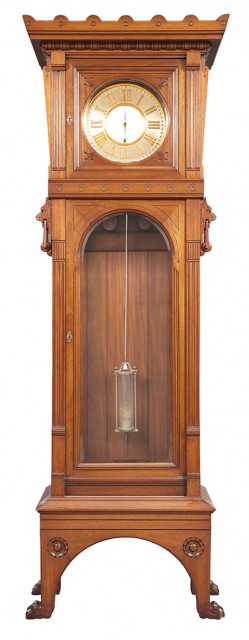American Aesthetic Movement
03/22/2017 Furniture & Decorative Arts

Rapid changes occurred in the last third of the 19th century in America including industrial growth, western expansion, a transportation revolution, and a period of rich artistic creativity with the decorative arts at the center. With easier travel methods and an expanded cultural exchange between countries, European designers and craftsmen flocked to America becoming the premier tastemakers and arbiters of style. They used elements of European culture to cultivate a fresh American decorative language. Within the period of flourishing artistic activity, this new language permeated not only the decorative arts, but also architecture, painting, collecting, art education and works in print. Known as the Aesthetic Movement, the new visual lexicon and set of principles critiqued previous modes of life and created a new class of manufacturers and consumers.
The roots for the Aesthetic Movement grew from the English Reform Movement in the 1850s and 60s. What began as a commentary on the Industrial Revolution, soon led to a social and aesthetic protest. British designers promoted the use of beauty in everyday objects and furnishings and wanted to elevate the decorative arts while using less exuberance and fewer elements of consumption. Englishman William Morris “argued that reform in art was a means of improving society” and called for the production of handcrafted and individual furniture.
Progressive Aesthetic Movement ideas found their earliest expression in America in Modern Gothic furniture. A distinct new decorative and design vocabulary was introduced by Bruce J. Talbert’s book Gothic Forms Applied to Furniture, Metal Work, and Decoration for Domestic Purposes (1867) along with Charles Locke Eastlake’s Hints on Household Taste in Furniture, Upholstery and Other Details (1868). Eastlake spoke against curves as they weakened furniture and were expensive to make. Abstracted gothic details such as large pulls, angular architecture, revealed construction, shallow carving, and reeding and incising were highlighted as primary forms of decoration. Particularly with the first Boston edition of Hints on Household Taste in 1872, the linkages between English and American designs were overt.
The Modern Gothic style, also known as Eastlake style, was promoted by Talbert and Eastlake. It called for a return to handcraftsmanship and a turn away from machine-made revival styles, as Morris had also preached. America was further introduced to Modern Gothic through exhibitions in the Philadelphia Centennial Exposition in 1876, reacting to the high Victorian style, such as ornately carved Rococo and Renaissance Revivals. Lasting from the 1870s-1880s, the Modern Gothic resonated with major decorating and cabinetmaking firms such as Herter Brothers and Tiffany Studios who completed lavish interiors in collaboration with architects and other artists.
In the forefront of the Aesthetic Movement were brothers Gustave (1830-1892) and Christian Herter (1839-1883). They immigrated to the United States from Stuttgart, Germany in 1848 and 1859, respectively, and their father had also been an established cabinetmaker. When Christian became a full partner at the Gustave Herter firm in 1864, the name changed to Herter Brothers. In 1865, the brothers established an interior decorating firm in New York City that quickly “became synonymous with high quality craftsmanship and luxury”. They held the most exclusive clients such as J. Pierpont Morgan and William H. Vanderbilt, and the best resources and connections to Europe. Gustave returned to Germany in 1870, leaving Christian in full artistic control to embrace the English Reform ideals and solidify the Herter Brothers’ style.
The firm was well-known for their Anglo-Japanesque furniture, complete with various Oriental ornaments, rectilinear structure, and their signature ebony colored wood and contrasting light-colored marquetry. While working in the Modern Gothic style, symmetrical patterns, shallow carvings, and incised details were often used. For example, a tall case clock in Doyle’s April 5 American sale, Lot 338, combines various stylistic elements including vestiges of the Renaissance Revival with decorative carved lion mask pulls and paw feet, a simplified structure, and restrained ornament using stylized incised floral and gothic motifs.
Another firm, Kimbel & Cabus also led cabinetmaking and interior design in New York City. Anthony Kimbel (d. 1895) came from Mainz, Germany, and worked with Joseph Cabus (1824-1894) after coming to the United States. Cabus had worked with Alexander Roux, another Victorian cabinetmaker whose strengths lay in revival styles. Together, A. Kimbel and J. Cabus borrowed inspiration from Talbert and Eastlake’s books, and the firm became one of the “leading interpreters of the Modern Gothic in furniture, architectural woodwork, and decoration”. The Kimbel & Cabus drawing room display at the Centennial Exposition revealed Modern Gothic furniture and decoration, including a similar desk as Lot 336. This lot in the American sale incorporates exaggerated decorative hinges, revealed construction, simplicity of form, and shallow linear incised imagery. By the time the Aesthetic Movement and Modern Gothic waned, the firm closed in 1882.
Both the Herter Brothers firm and Kimbel & Cabus flourished in New York, which became the style center of America in the 1870s. Catering to elite clients and producing some of the most well-known furniture of their time, the two firms worked on domestic projects for individual clients on single commissions. They also worked on large institutional projects such as the Seventh Regiment Armory on Park Avenue, where they designed rooms around 1879-1880 with other decorative firms. The cross-fertilization of artists, craftsmen, and design ideas between Europe and America as well as the rise of interior design led to the creation of quality domestic interiors complete with fine cabinetmaking on a scale unparalleled in the United States.
-- Leigh Kendrick, Furniture & Decorative Arts Department
SOURCES
Howe, Katherine S., Alice Cooney Frelinghuysen and Catherine Hoover Voorsanger. Herter Brothers, Furniture and Interiors for a Gilded Age. New York: Harry N. Abrams., Inc., 1994.
Burke, Doreen Bolger, Jonathan Freedman, Alice Cooney Frelinghuysen, David A. Hanks, Marilyn Johnson, James D. Kornwolf, Catherine Lynn, Roger B. Stein, Jennifer Toher, and Catherin Hoover Voorsanger. In Pursuit of Beauty: Americans and the Aesthetic Movement. New York: The Metropolitan Museum of Art, 1986.